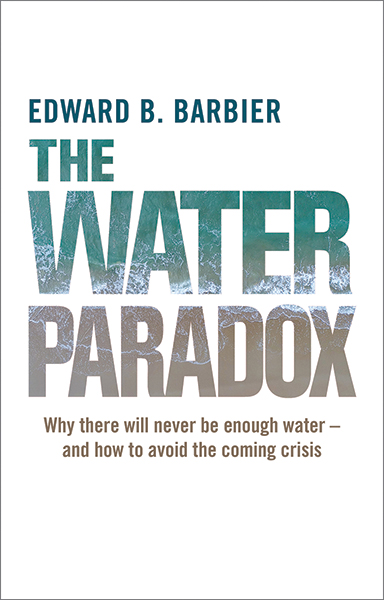It’s overmanaged, undercharged, and becoming scarce
Renowned CSU economist Edward Barbier has a few ideas about the world’s increasingly serious water crisis.
He says we have mismanaged our freshwater supplies by not charging enough for the natural resource and by sticking to an antiquated system of determining water rights.
“We get trapped into thinking that water is like any other resource, such as oil, and it’s not,” Barbier explains. “Unlike oil, when water becomes increasingly scarce, markets and policies do not automatically account for its rising scarcity, and so we end up managing it poorly.”

In The Water Paradox: Overcoming the Global Crisis in Water Management, which will be published by Yale University Press in February 2019, Barbier uses an economic lens to examine the history of water management, chronicling much of the history of our water use, from the creation of the city-state 10,000 years ago through the Industrial Revolution, and offers possible solutions to fix it.
“When the history of the early twenty-first century is written, scholars will be perplexed by a puzzling paradox,” he writes in the book’s preface. “With overwhelming scientific evidence pointing to growing overuse and scarcity of freshwater, why did the world not mobilize its vast wealth, ingenuity and institutions to avert this crisis?”
Barbier, a professor in CSU’s Department of Economics, acknowledges that his call to charge more for water — and change the way water rights have been managed — will not be popular in some circles, but remaining silent while the same patterns continue is no longer an option.
He explains that the system for managing water was created during a time when there were fewer people, plenty of freshwater, and much less demand for it. He says we haven’t updated our water institutions, incentives, and innovations to keep up with the growth in competing demands that has made it such a valuable — but increasingly scarce — resource today.
As an example, he points to the fact that in the American West, water rights are based on prior appropriation — whoever was first to use it, in a beneficial way, got to keep their water rights in perpetuity. And it’s not easy for someone who has a surplus of water to sell or trade it to another person that needs it more, Barbier says.
Plus, we have a “use it or lose it” water rights system. In a wet year, farmers who fear losing their rights if they don’t use all their water may grow crops that require more irrigation instead of crops well-suited for their climate, to protect their regular amount of water in case the following year is dry. Barbier asks why it’s not easier for someone with extra water to sell it to an entity that’s in dire need in a given year, without risking the loss of their water rights in future years. Also, in some Western states, leaving water in rivers, streams and lakes is not legally considered a “beneficial use,” even though these freshwater ecosystems are valuable for recreation, fishing, and other environmental uses. So any farmer or other water-rights holder who leaves water in the environment risks losing the rights to that water.
“We accept this over-regulation of water because we’ve always done it that way,” he says. And yet, he adds, we have under-regulated in certain areas, like the use of groundwater, which serves as the backup to surface water for farmers and developers alike.
Barbier points out that water owned by some irrigation districts can only be used for agricultural purposes. Agriculture is heavily subsidized, he says, and farmers generally don’t pay for all the costs of getting water to their fields. The United States uses 80 percent of its water for agriculture, even though farming and related industries generated only about 5.5 percent of the country’s gross domestic product in 2015, and agricultural jobs accounted for only about 11 percent of total U.S. employment in 2016, according to the U.S. Department of Agriculture. Yet, the fastest growing demands for water are for residential, urban, and industrial use, which means that water is used too cheaply, and there is not enough of it to meet all these competing demands.
It’s all part of a “vicious cycle,” he says in the book.
“Markets and policy decisions currently do not reflect the rising economic costs associated with exploiting more freshwater resources,” Barbier writes. “This in turn leads to freshwater infrastructure and investments that are accompanied by higher environmental and social damages. These damages are reflected in increased depletion of water resources, pollution, degradation of freshwater ecosystems, and ultimately, rising water scarcity. But because the economic costs of this scarcity continue to be ignored in decision-making, the consequences for current and future well-being are underestimated.”
Adjusting markets and improving policies to manage the growing scarcity of water would make people more serious about conserving this resource, he says. Increasing the cost of water would also generate funding for better and more efficient water infrastructure, like pipelines and storage areas, and would foster more water-saving innovations for consumer goods like washing machines, baths, and showers as well as agricultural improvements, such as more water-efficient irrigation technology.
Barbier also suggests employing “block pricing,” in which a low-income, urban community that uses less water pays a lower price than a wealthy area with huge homes that use more. Perhaps, he says, water decisions should be based on the needs of a given river basin rather than politically drawn state and national borders. “Water shouldn’t be cheaper in Phoenix than in Fort Collins,” Barbier says.
In his preface, he concludes, “By developing appropriate governance and institutions for water management, instigating market and policy reforms, addressing global management issues, and improving innovation and investments in new water technologies, we should better protect freshwater ecosystems and secure sufficient beneficial water use for a growing world population.”
More information about his book is available from Yale University Press.

